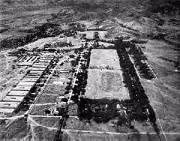![]() The Pacific War Online Encyclopedia
The Pacific War Online Encyclopedia
|
| Previous: Clagett, Henry B. | Table of Contents | Next: Clark, Joseph J. |

U.S. Army
Clark Field (120.558E
15.186N) was the most important military
airfield in the Philippines
at the start of the Pacific War. It was established next to Fort Stotsenberg
in 1919 as a small runway running along a highway just outside the
base. By late 1941 it had a concrete runway capable of operating the heaviest
bombers. Gasoline stores totaled 250,000 gallons (950,000
liters) and the field
was protected by 12 3" (76mm) fixed antiaircraft
guns and 24 75mm
truck-mounted guns. However, none of these could
reach above 27,000 feet (8200m) and their ammunition was incredibly unreliable;
one estimate is that five out of six shells was a dud.
The Clark Field Disaster, On 8 December 1941 the field
based 19 B-17s
of 28
and 30
Heavy Bombardment Squadrons and 19 P-40Bs of 20 Fighter
Squadron. For reasons never adequately explained, the Japanese were able to destroy most of these aircraft
on the ground nine
hours after the attack on Pearl
Harbor.
The Japanese had originally planned to attack Clark Field at dawn on the morning of 8 December 1941. However, heavy fog delayed the launch of the attack force (53 G3M Nells and G4M Bettys and 34 A6M Zeros from 11 Air Fleet ) for several hours. Meanwhile the Americans received word of the attack on Pearl Harbor, but according to Lewis Brereton, commanding the American air forces in the Philippines, his request to launch a dawn attack on the Japanese on Formosa was put off for several hours by MacArthur's headquarters. According to Sutherland, MacArthur's chief of staff, Brereton was supposed to have moved the B-17s to Del Monte to keep them out of range of the Japanese air forces. There was one radar station operating in the Philippines, at Iba, but communications with the other airfields on Luzon was so poor that reports often took hours to reach their destinations.
At about 0900 reports were received of Japanese bombers making for Baguio and Tuguegarao. The B-17s immediately took off without bomb
loads to avoid being caught on the ground, while 20 Fighter Squadron
raced north in a vain attempt to intercept the Japanese aircraft. The
American aircraft then landed to refuel and rearm, and they were still
on the ground when the main Japanese raid arrived. Iba had detected the
raid on radar, but the report to Clark was delayed and did not arrive
before the Japanese. Furthermore, a heavy haze of dust at Del Carmen
prevented 34 Fighter Squadron from covering Clark as ordered.
The Japanese were barely able to believe their good luck at catching the American aircraft still on the ground and without fighter cover. The Japanese bombers demolished the base facilities and communications center while the fighters
strafed
the
runway, destroying almost all the aircraft. The raid rendered Clark
useless even as a staging field and ensured Japanese control of the
air over
the Philippines.
Clark Field was seized by the Japanese at the end of
December 1941, and Japanese aircraft were operating off the runways by
10 January 1942. The Japanese subsequently build up Clark into a major
base complex with six all-weather runways and another nine satellite
runways.
Recapture of Clark Field. By 1945 Clark Field was defended by 30,000 troops of Kembu Group (Tsukada), an ad hoc formation built around the headquarters of 1 Airborne Raiding
Group, with orders to deny the Americans the use of the field for as long as possible. Kembu Group had a large number of automatic weapons salvaged from wrecked aircraft and was deeply entrenched in the high ground west of the airfield, from which it could direct fire onto the runways. Furthermore, Kembu Group threatened the flank of the drive on Manila. Although 145 Regiment reached the first runways by 26 January 1945, and XI Corps landed on the west coast of Luzon to the rear of Kembu Group on 29 January, it took the rest of January for 37 Division to clear the area around Clark Field. Kembu Group was driven into the Zambales Mountains in February and remained bottled up for the remainder of the war.
References
Craven and Cate (1947; accessed 2012-1-25)
Smith (1961; accessed 2012-1-25)
The Pacific War Online Encyclopedia © 2007, 2010 by Kent G. Budge. Index